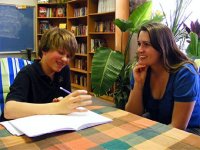It’s Not What’s Wrong With the Children, It’s What’s Happened to Them
Instead of punitive discipline that limits students’ potential, we must adopt a more holistic approach and address the life circumstances that are causing their behavior.
It has been said to me many times that it’s the child who is acting out that needs you the most. Yet all too often the systems that are most likely to deal with young people in crisis do more damage than good.
A recent report from the Juvenile Law Center on how to improve outcomes for young people in the juvenile justice and child welfare systems underscores this point. The report, which was sponsored by the Robert Wood Johnson Foundation (RWJF), points out that the juvenile justice system relies heavily on a strategy of harsh punishment when its real goal should be helping and healing young people who are struggling.
When young people have behavioral challenges, the system usually asks, “What is wrong with this child, and how do we stop it?” Instead we ought ask, “What happened to this child, and how do we help them?”
We see the same problems in our education system as well. For example, children who are exposed to traumatic events in early childhood are more likely to act out in school. Preschools all too often respond to that behavior by suspending or expelling children. Children of color are especially vulnerable to harsh discipline. Consider recent data (PDF) from the U.S. Department of Education’s Office for Civil Rights, which shows that children of color are far more likely to be suspended or permanently expelled from preschool. For example, black children account for 18 percent of the preschool population, but represent 48 percent of suspensions.
These preschool suspensions are particularly troubling because of how they might shape a child’s future pathway. A suspension may or may not change a child’s behavior, but what is certain is that it provides the first touch of punishment that may latch on and follow that child throughout his or her education and life experiences.
Reasons for Hope
I recently went to Baltimore to learn about some of the innovative ways in which community leaders are trying to replace harsh punishment with caring support. I had the chance to sit down with third-party, school-based mediators at the Center for Dispute Resolution at University of Maryland (C-DRUM). Based at the School of Law, C-DRUM addresses school truancy and discipline cases in communities where families are under high degrees of stress, especially from economic hardship and community violence. C-DRUM’s legal mediators help school-aged students and their families work with educators to address the issues at hand and get the kids back into the classroom.
When the C-DRUM mediators ask what happened to these children to keep them from coming to school or prompt them to act out in class, they often find that the problem is health-related. Children with untreated asthma often act out and get sent to the principal instead of the nurse. Children living in inadequate housing with problems such as mold and insects might miss school because they’re chronically sick. When parents have poor health, children are often sidelined or unable to complete assignments because of their role as part-time caretakers.
Once C-DRUM is able to discover what is happening, it’s easier to find solutions that help a child to get back to school and back on track. For the majority of communities without such an important resource, we can easily imagine how thousands and thousands of children fall further behind or drop out permanently.
Alternatives and Solutions
So what other alternatives are we seeing? How can we implement practical solutions that move us from a policy of zero tolerance to a practice of nurturing resilience? RWJF funds several school-based programs working to address the cycle of trauma and discipline, a few of which are listed below. I hope they inspire new thinking about ways for communities to create alternate pathways for youth who are challenged with various adversities.
Trauma Smart: Trauma Smart is an early-childhood trauma intervention model that addresses the effects of complex trauma—such as community and family violence, poverty, illness, and homelessness—for preschool-age children, their families, and the Head Start teachers who care for them.
System of Care: Georgia’s Clayton County Juvenile Court has a program called System of Care that partners with local schools and law enforcement to find ways of disciplining young people while keeping them in school and out of the juvenile justice system. Since 2004, the program has reduced school arrests by 83 percent and gained national attention as a promising model.
The Safe Schools Consortium: The Safe Schools Consortium is a multi-stakeholder collaborative in Chicago that works to keep kids in school and promotes safe school climates for all students. Specifically, it is working to help schools replace harsh disciplinary policies, which lead to high levels of suspensions and expulsions, with a commonsense approach that allows young people to take responsibility and learn from their mistakes while they are in school.
All of us must to work together to replace cycles of trauma and punishment if we hope to build a culture of health and learning. As long as our first instinct is punishment instead of healing, we will lose kids before they ever have the opportunity to find their own potential. There are solutions out there. At home and in school, we want our kids to be curious. We encourage them to ask why. As grown-ups, we should expect the same of ourselves.
